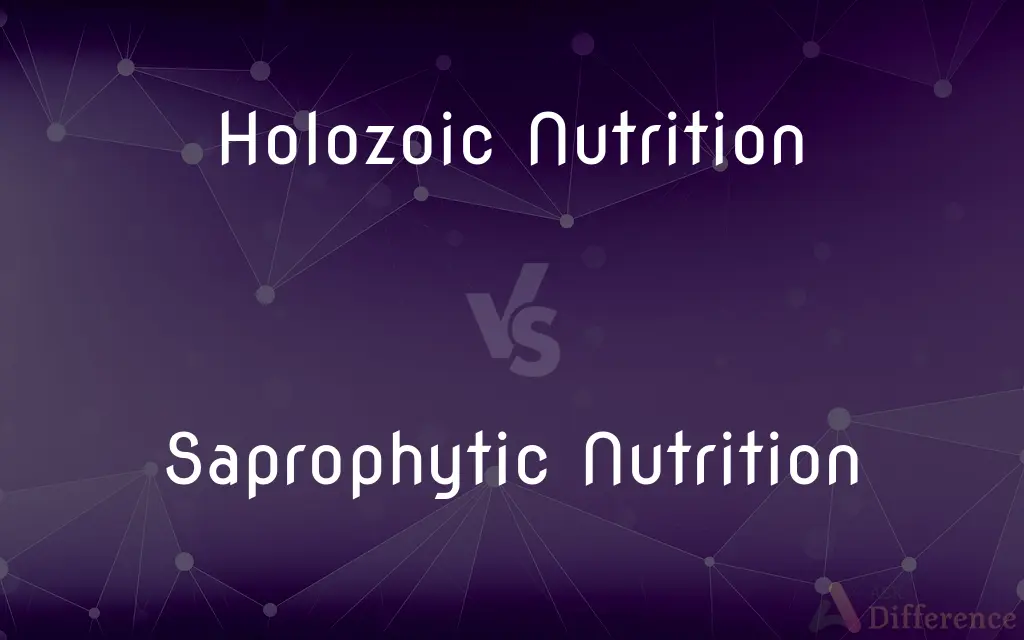Holozoic Nutrition vs. Saprophytic Nutrition — What's the Difference?
By Tayyaba Rehman — Published on January 18, 2024
Holozoic Nutrition involves organisms ingesting and internally digesting solid food, while Saprophytic Nutrition involves absorbing nutrients from decaying organic matter.

Difference Between Holozoic Nutrition and Saprophytic Nutrition
Table of Contents
ADVERTISEMENT
Key Differences
Holozoic Nutrition is characterized by the ingestion of solid food particles followed by internal digestion, typical in animals. Saprophytic Nutrition involves the absorption of nutrients from decomposed organic material, common in fungi and some bacteria.
Organisms with Holozoic Nutrition follow a process involving ingestion, digestion, absorption, assimilation, and egestion. In contrast, Saprophytic Nutrition organisms secrete enzymes externally to decompose matter and then absorb the nutrients.
Holozoic Nutrition is a complex process requiring an organized digestive system. Saprophytic Nutrition, however, is simpler, relying on external digestion and absorption.
In Holozoic Nutrition, organisms actively hunt or gather food, whereas Saprophytic Nutrition organisms are mostly immobile, feeding on dead or decaying matter.
Holozoic Nutrition supports a wide range of dietary habits, including herbivory, carnivory, and omnivory. Saprophytic Nutrition is exclusively heterotrophic, relying on organic matter for sustenance.
ADVERTISEMENT
Comparison Chart
Food Source
Solid food particles
Decaying organic matter
Digestion Process
Internal digestion
External digestion (enzyme secretion)
Nutrient Absorption
After internal digestion
Directly from decomposed material
Mobility
Often mobile, seeking food
Mostly immobile, reliant on available matter
Dietary Habits
Diverse (herbivory, carnivory, omnivory)
Heterotrophic, decomposing organic substances
Compare with Definitions
Holozoic Nutrition
Characterized by a complete digestive process.
Fish demonstrate holozoic nutrition through their feeding habits.
Saprophytic Nutrition
Reliant on organic matter for sustenance.
Saprophytic bacteria in compost piles decompose organic waste.
Holozoic Nutrition
Includes ingestion, digestion, absorption, assimilation, and egestion.
Cats use holozoic nutrition to process their meat-based diet.
Saprophytic Nutrition
Typical in fungi and some bacteria.
Yeasts obtain nutrients through saprophytic nutrition from sugars in their environment.
Holozoic Nutrition
Supports diverse dietary habits like herbivory and carnivory.
Bears are examples of holozoic nutrition, consuming both plants and animals.
Saprophytic Nutrition
Absorption of nutrients from decomposed organic material.
Mushrooms utilize saprophytic nutrition by absorbing nutrients from dead wood.
Holozoic Nutrition
Involves ingesting and digesting solid food internally.
Humans exhibit holozoic nutrition by eating and digesting various foods.
Saprophytic Nutrition
Does not involve ingestion of solid food.
Mold on bread derives its nutrients through saprophytic nutrition.
Holozoic Nutrition
Common in animal kingdom with varying diets.
Birds follow holozoic nutrition by eating seeds or insects.
Saprophytic Nutrition
Involves external digestion using secreted enzymes.
Certain soil bacteria exhibit saprophytic nutrition by breaking down leaf litter.
Common Curiosities
How does holozoic nutrition differ in carnivores and herbivores?
It differs in the type of food ingested and digested.
Can holozoic nutrition vary within the same species?
Yes, depending on the available food and individual dietary habits.
Are all animals holozoic?
Most are, but there are exceptions like parasitic animals.
Do saprophytes play a role in the ecosystem?
Yes, they are crucial for decomposing organic matter and nutrient recycling.
Can an organism switch between holozoic and saprophytic nutrition?
No, these are fixed nutritional strategies based on organism's physiology.
What is holozoic nutrition?
It's a nutritional process involving ingestion and internal digestion of food.
How do saprophytic organisms obtain energy?
They secrete enzymes to break down organic matter and then absorb the nutrients.
Which organisms typically exhibit holozoic nutrition?
Most animals, including humans, demonstrate holozoic nutrition.
What is saprophytic nutrition?
It's a nutritional process where organisms absorb nutrients from decaying organic matter.
Are all fungi saprophytic?
Most fungi are saprophytic, but there are also parasitic and symbiotic fungi.
What factors influence the efficiency of holozoic nutrition?
Factors include the type of food, digestive efficiency, and metabolic rate.
Do saprophytes have a digestive system?
No, they lack a digestive system and rely on external digestion.
Can a saprophytic organism be harmful?
While most are beneficial, some can cause decay in food and property.
Is holozoic nutrition more complex than saprophytic nutrition?
Generally, yes, due to the processes of ingestion, digestion, and assimilation.
How do saprophytes contribute to soil fertility?
They break down organic material, enriching the soil with nutrients.
Share Your Discovery

Previous Comparison
Affiliate Marketing vs. Digital Marketing
Next Comparison
Dell Optiplex vs. Lenovo ThinkcentreAuthor Spotlight
Written by
Tayyaba RehmanTayyaba Rehman is a distinguished writer, currently serving as a primary contributor to askdifference.com. As a researcher in semantics and etymology, Tayyaba's passion for the complexity of languages and their distinctions has found a perfect home on the platform. Tayyaba delves into the intricacies of language, distinguishing between commonly confused words and phrases, thereby providing clarity for readers worldwide.
















































